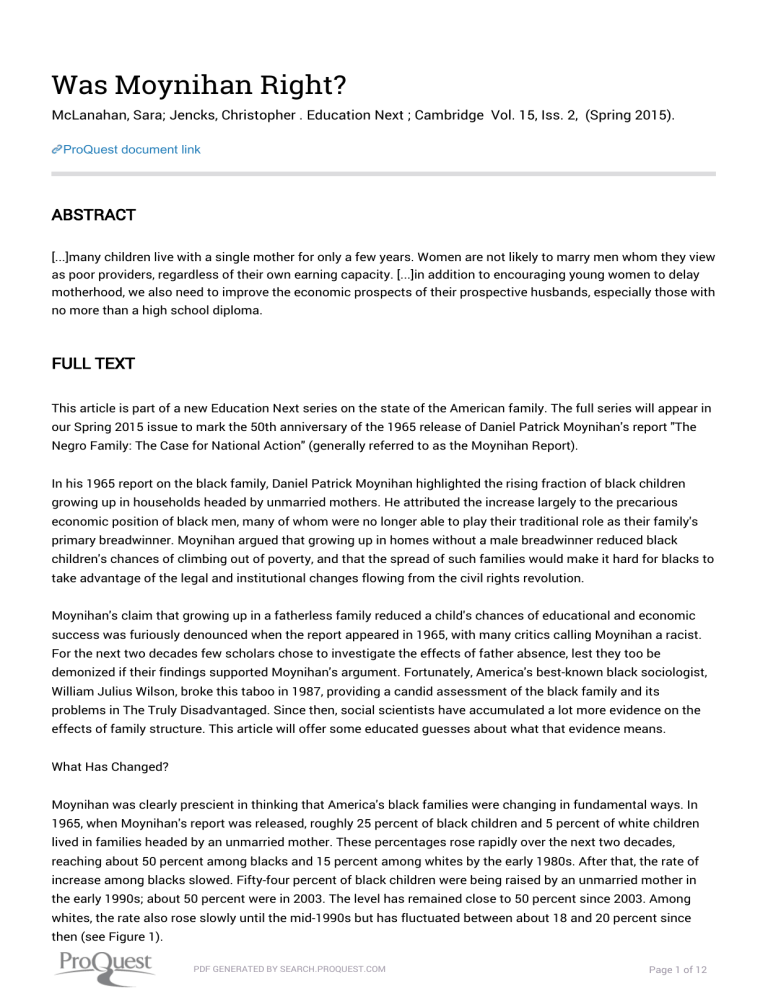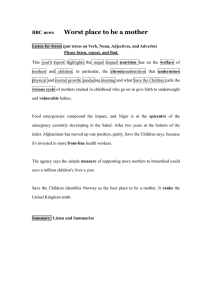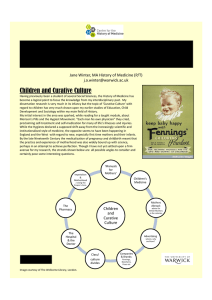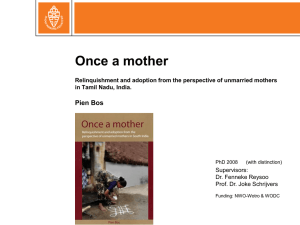
Was Moynihan Right? McLanahan, Sara; Jencks, Christopher . Education Next ; Cambridge Vol. 15, Iss. 2, (Spring 2015). ProQuest document link ABSTRACT [...]many children live with a single mother for only a few years. Women are not likely to marry men whom they view as poor providers, regardless of their own earning capacity. [...]in addition to encouraging young women to delay motherhood, we also need to improve the economic prospects of their prospective husbands, especially those with no more than a high school diploma. FULL TEXT This article is part of a new Education Next series on the state of the American family. The full series will appear in our Spring 2015 issue to mark the 50th anniversary of the 1965 release of Daniel Patrick Moynihan's report "The Negro Family: The Case for National Action" (generally referred to as the Moynihan Report). In his 1965 report on the black family, Daniel Patrick Moynihan highlighted the rising fraction of black children growing up in households headed by unmarried mothers. He attributed the increase largely to the precarious economic position of black men, many of whom were no longer able to play their traditional role as their family's primary breadwinner. Moynihan argued that growing up in homes without a male breadwinner reduced black children's chances of climbing out of poverty, and that the spread of such families would make it hard for blacks to take advantage of the legal and institutional changes flowing from the civil rights revolution. Moynihan's claim that growing up in a fatherless family reduced a child's chances of educational and economic success was furiously denounced when the report appeared in 1965, with many critics calling Moynihan a racist. For the next two decades few scholars chose to investigate the effects of father absence, lest they too be demonized if their findings supported Moynihan's argument. Fortunately, America's best-known black sociologist, William Julius Wilson, broke this taboo in 1987, providing a candid assessment of the black family and its problems in The Truly Disadvantaged. Since then, social scientists have accumulated a lot more evidence on the effects of family structure. This article will offer some educated guesses about what that evidence means. What Has Changed? Moynihan was clearly prescient in thinking that America's black families were changing in fundamental ways. In 1965, when Moynihan's report was released, roughly 25 percent of black children and 5 percent of white children lived in families headed by an unmarried mother. These percentages rose rapidly over the next two decades, reaching about 50 percent among blacks and 15 percent among whites by the early 1980s. After that, the rate of increase among blacks slowed. Fifty-four percent of black children were being raised by an unmarried mother in the early 1990s; about 50 percent were in 2003. The level has remained close to 50 percent since 2003. Among whites, the rate also rose slowly until the mid-1990s but has fluctuated between about 18 and 20 percent since then (see Figure 1). PDF GENERATED BY SEARCH.PROQUEST.COM Page 1 of 12 As whites constitute a substantial majority of Americans, whites also comprise the largest share of single-mother families. The racial makeup of single-mother families has not changed very much over time. In 1970, 31 percent of single-mother families were black, 68 percent were white, and 1 percent were "other race." In 2013, the figures were 30 percent black, 62 percent white, and 8 percent "other." Readers should bear in mind that the terms "unmarried" and "single" refer to a mother's marital status, not to whether she lives with a partner. Thus, living with a "single" mother does not necessarily mean that a child is living in a "fatherless household." Unmarried couples living with children, that is, parents or partners who cohabit, were relatively rare in 1960. They have become increasingly common in the last 20 years. Recent estimates indicate that roughly one-quarter of all children living with an unmarried mother are living with a mother who has a live-in partner. This figure is about 33 percent among white children, 12 percent among black children, and 29 percent among Hispanic children. Figure 1 shows children's living arrangements in specific years, but it does not tell us what percentage of children ever live with a single mother while they are growing up. Demographers estimate that more than half of all American children are now likely to live with a single mother at some point before they reach age 18, even though only 24 percent live with a single mother in any one year. The difference between the two estimates reflects the fact that married mothers often separate, divorce, or (less often) become widows, while unmarried mothers often marry or remarry. As a result, many children live with a single mother for only a few years. The transitory nature of marital status becomes even clearer if we compare the fraction of children born to unmarried mothers in a given year with the fraction living with an unmarried mother in subsequent years. Figure 2 shows trends in the percentage of mothers who were unmarried at the time they gave birth to a child. In 1960, only 5 percent of all births were to unmarried mothers. By 2010, the number was nearly 41 percent. The trend leveled off for all births in 1994 but rose again after 2000, with paths diverging by race and ethnicity. By 1990, roughly 70 percent of all black births were to unmarried mothers, and the figure has hovered near 70 percent since that time. Yet in 2013, only about 50 percent of black children under age 18 were living with an unmarried mother. Some of the "missing" 20 percent were living with their fathers, because their mother had married their father after the child was born. But in many cases, the mother had married someone else before her child's 18th birthday. Although the fraction of children born to unmarried mothers has not risen among blacks since the 1990s, it has continued to increase among whites and Hispanics, nearing 36 percent for whites and topping 50 percent for Hispanics by 2012. The meaning of single motherhood has also changed since the 1960s. Today's single mothers are far less likely than their predecessors to have ever been married. In 1960, 95 percent of single mothers had been married at some point in the past. The major sources of single motherhood were separation from a spouse, divorce, and widowhood, in that order. By 2013, only half of all single mothers had ever been married. The historical shift from formerly married to never-married mothers has meant that single motherhood usually occurs earlier in a child's life. Mothers who marry and then divorce typically spend a number of years with their husband before separating. Today, many women become single mothers when their first child is born. The shift to never-married motherhood has probably weakened the economic and emotional ties between children and their absent fathers. A second change is that unmarried motherhood has spread fastest among mothers who have not completed PDF GENERATED BY SEARCH.PROQUEST.COM Page 2 of 12 college. Between 1980 and 2010 the fraction of black children living with an unmarried mother rose from 55 to 66 percent (10 points) among those whose mother had not finished high school, from 43 to 50 percent (7 points) among those whose mother had finished high school but not college, and from 23 to 28 percent (5 points) among those whose mother had graduated from a four-year college. Among white children with mothers who had not finished high school, the estimated fraction living with an unmarried mother rose only from 16.9 percent in 1980 to 18.2 percent in 2010, but the 2010 estimate is based on a small sample, and we cannot rule out the possibility that the true increase was considerably larger. The increase was from 10 to 21 percent among white children with mothers who had finished high school but not college, and from 6.7 to 7.3 percent among white children whose mothers had completed college (see Figure 3). The fact that single motherhood is increasing faster among women with less than a college degree means that children growing up with a single mother are likely to be doubly disadvantaged. They spend less time and receive less money from their biological fathers than children who live with their fathers. At the same time, the primary breadwinner in the family--the mother--has lower earnings than the typical mother in a married-parent family. The official poverty rate in 2013 among all families with children was 40 percent if the family was headed by an unmarried mother and only 8 percent if the family was headed by a married couple (see Figure 4). Among blacks, the rates were 46 percent in single-mother families and 12 percent in married-parent families. Among Hispanics, the figures were 47 percent and 18 percent, and among whites the rates were 32 percent and 4 percent, respectively. The Fragile Family Recent evidence on the impact of these trends comes from the Fragile Families and Child Wellbeing Study, which is following a cohort of nearly 5,000 children born in large U.S. cities between 1998 and 2000. Roughly threequarters of these children were born to unmarried parents. Just under 50 percent of the parents are black, while about 35 percent are Hispanic. Researchers interview parents and assess children every few years to learn about family dynamics and gauge the health and well-being of the participants. The study finds that couples who are cohabiting at the time of the child's birth split up much sooner than couples who were married. Nearly half of cohabiting parents break up within five years of the child's birth, compared to only 20 percent of married parents. Once a mother's relationship with her baby's father ends, she is likely to form relationships with new partners, and she typically has one or more children with a new partner. Of course, divorced mothers also form new partnerships and often have children with their new partners. But the interval before this occurs is usually longer among divorced mothers than among mothers who are cohabiting or living alone at the time of their child's birth. Among the latter group, 61 percent live with a new partner and 11 percent live with three or more new partners before the child is five years old. Among mothers who are married at the time of a birth, those proportions are only 8 percent and 1 percent, respectively. The high rate of partner turnover during a mother's peak fertility years means not only that her children now experience more changes in the adults with whom they live, but also that they are now more likely to have half siblings, who have different fathers, paternal grandparents, and other relatives. Half siblings and their kin create additional complexity in children's families. In the Fragile Families study, 60 percent of children born to unmarried mothers had a half sibling by the time they were five years old, and 23 percent had half siblings fathered by two or more different men. Among children born to married mothers, the comparable figures are 18 and 6 percent. High levels of instability and complexity have important consequences for children's home environment and the quality of the parenting they receive. Both the departure of a father and the arrival of a mother's new partner PDF GENERATED BY SEARCH.PROQUEST.COM Page 3 of 12 disrupt family routines and are stressful for most children, regardless of whether the father is married to their mother or merely cohabiting with her. A nonresident father may also be less willing to keep paying child support if he believes his payments will be shared with another man's child. Such problems are magnified in families with several nonresident fathers. Among fathers in the study who were married to their child's mother when the child was born but were not living with the child nine years later, three-quarters were still providing some economic support for their child, according to an analysis by Rutgers University professor Lenna Nepomnyaschy. Among fathers who were cohabiting with the mother when their child was born but were living elsewhere nine years later, only 60 percent were providing some economic support, the same as the percentage among fathers who had never lived with their child. The Effect on Children Was Moynihan right in suggesting that children whose parents divorce or never marry have more than their share of problems? This question has been hotly debated ever since the publication of Moynihan's report. On the one hand, growing up without both biological parents is clearly associated with worse average outcomes for children than growing up with them. Specifically, children growing up with a single mother are exposed to more family instability and complexity, they have more behavior problems, and they are less likely to finish high school or attend college than children raised by both of their parents. On the other hand, these differences in children's behavior and success might well be traceable to differences that would exist even if the biological father were present. In recent years, researchers have begun to use what they call "quasi-experimental" approaches to estimate the causal impact of growing up apart from one's biological father. Some studies compare the outcomes of children living in states with liberal versus restrictive divorce laws. Others compare siblings who were different ages in the year when their father moved out. Still others compare the same child before and after the father left the child's household. One important limitation of these studies is that while they all focus on children who are not living with both of their biological parents, they differ with respect to their comparison group, whether it is children raised by their mother alone, by their mother and a new spouse, or by their mother and a new partner to whom she is not married. Nonetheless, when taken together these studies are beginning to tell a consistent story. A recent review of 45 studies using quasi-experimental methods concluded that growing up apart from one's father does reduce a child's life chances in many domains. The review's authors examined the effects of a father's absence on outcomes in four domains: educational attainment, mental health, labor market performance, and family formation. Growing up with only one biological parent reduces a child's chances of graduating from high school by about 40 percent, which is similar to the effect of having a mother who did not finish high school rather than one who did. The absence of one's biological father has not been shown to affect a child's verbal and math test scores, however. The evidence for other indicators of educational performance, such as high school grades, skipping school, and college aspirations, is mixed, with some studies finding that father absence lowers school attendance and aspirations and others finding no effect. Most studies find larger effects on boys than on girls. How might we reconcile the fact that a father's absence affects high school graduation with the lack of evidence that it affects test scores? The answer appears to be that a father's absence increases antisocial behavior, such as aggression, rule breaking, delinquency, and illegal drug use. These antisocial behaviors affect high school completion independent of a child's verbal and math scores. Thus it appears that a father's absence lowers children's educational attainment not by altering their scores on cognitive tests but by disrupting their social and PDF GENERATED BY SEARCH.PROQUEST.COM Page 4 of 12 emotional adjustment and reducing their ability or willingness to exercise self-control. The effects of growing up without both parents on aggression, rule breaking, and delinquency are also larger for boys than for girls. Since these traits predict both college attendance and graduation, the spread of single-parent families over the past few decades may have contributed to the growing gender gap in college attendance and graduation. The gender gap in college completion is much more pronounced among children raised by single mothers than among children raised in two-parent families. University of Chicago researcher Marianne Bertrand and Jessica Pan of the National University of Singapore investigated several mechanisms that might explain how a father's absence could affect the educational attainment of sons more than daughters. They found that single mothers spend more time with girls and feel closer to girls than to boys, for example. More important, boys are far more sensitive than girls to parenting practices such as spending time with a child, emotional closeness, and avoiding harsh discipline. These practices, which are much more common in families that include a father, partly explain why boys with absent fathers have more behavior problems and are more likely to be suspended from school. Boys also respond more negatively than girls to having been raised by a teenage mother and to having grown up in a family with below-average income. Single motherhood is highly correlated with both teenage childbearing and low income, so these differences presumably help explain the unusually negative consequences for boys of growing up with a single mother. There is no strong evidence that single motherhood has different effects on black children than on white children. When we turn to black-white differences in the effects of single motherhood on children, we might expect the effects to be more negative for black than for white children, particularly for black boys, because single black mothers are younger, less educated, and poorer than single white mothers. Yet the fact that single motherhood has long been more common among blacks than whites could also have helped black families develop better systems for coping with a father's absence. Consistent with these conflicting hypotheses, there is no strong evidence either that single motherhood has different effects on black children than on white children or that the effects are the same. A few studies find weaker effects for blacks, and other studies find no significant racial difference. There is consistent evidence that a father's absence reduces a child's chances of employment, but the evidence on whether it affects the earnings of those who do find work is inconclusive. Similarly, there is solid evidence that absence of a father during childhood increases the chances that a child will divorce as an adult and that a daughter will have a nonmarital birth. The evidence on whether a father's absence affects the likelihood that a child will marry is inconclusive. Is Marriage the Solution? These findings do not mean that children would necessarily be better-off if their biological parents were married. Children with unmarried mothers are more likely than other children to have a biological father who is in prison, beats his partner, cannot find or keep a steady job, and/or makes his living by selling drugs. None of these characteristics is associated with good outcomes for children. Sara Jaffee, professor of psychology at the University of Pennsylvania, and her colleagues found that living with a father who engages in high levels of antisocial behavior increases children's conduct problems. While problems of this kind may sometimes diminish if a mother marries such a father--living with the mother and child may motivate the father to change his behavior, for example--there are also many instances in which that does not happen. Furthermore, even when a child's absent father is a model citizen, the mother often has problems that marriage PDF GENERATED BY SEARCH.PROQUEST.COM Page 5 of 12 cannot solve. Unmarried mothers have seldom done well in school, many lack even a high school diploma, and few have completed college. If these mothers find work, their earnings are usually lower than those of married mothers who work, and their hours are often long, erratic, or both. Unmarried mothers are also more likely than married mothers to have physical and mental health problems, and probably less likely to have habits or skills that help children escape from poverty. Of course, trying to raise children alone on a tiny budget is likely to exacerbate whatever problems a mother had initially. But marrying the man who fathered her child may magnify a mother's problems rather than solve them. What Can Be Done? Unmarried parents are not that different from married parents in their behavior. Both groups value marriage, both spend a long time searching for a suitable marriage partner, and both engage in premarital sex and cohabitation. The key difference is that one group often has children while they are searching for a suitable partner, whereas the other group more often has children only after they marry. Changing this dynamic would require two things. First, we would need to give less-educated women a good reason to postpone motherhood. The women who are currently postponing motherhood are typically investing in education and careers. These women use contraceptive methods that are more reliable, and they use these methods more consistently. Postponing fertility in these ways would also have benefits for women who currently do not do so. They would be more mature when they became mothers, and they would probably do a better job of selecting suitable partners. Nonetheless, postponing fertility will not solve the problem of nonmarital childbearing unless the economic prospects of the young men who father the children also improve. Women are not likely to marry men whom they view as poor providers, regardless of their own earning capacity. Thus, in addition to encouraging young women to delay motherhood, we also need to improve the economic prospects of their prospective husbands, especially those with no more than a high school diploma. This will not be easy. But it would improve the lives of the men in question, perhaps reduce their level of antisocial behavior, and improve the lives of their children, through all the benefits that flow from a stable home. Sara McLanahan is professor of sociology and public affairs at Princeton University. Christopher Jencks is professor of social policy at the Harvard Kennedy School. PDF GENERATED BY SEARCH.PROQUEST.COM Page 6 of 12 Enlarge this image. PDF GENERATED BY SEARCH.PROQUEST.COM Page 7 of 12 Enlarge this image. PDF GENERATED BY SEARCH.PROQUEST.COM Page 8 of 12 Enlarge this image. PDF GENERATED BY SEARCH.PROQUEST.COM Page 9 of 12 Enlarge this image. Enlarge this image. PDF GENERATED BY SEARCH.PROQUEST.COM Page 10 of 12 Enlarge this image. DETAILS Subject: Single parents; Marriage; Mothers; Divorce; Families &family life; Children &youth; African Americans; Births; Whites; Marital status Location: United States--US People: Moynihan, Daniel P Publication title: Education Next; Cambridge Volume: 15 Issue: 2 Publication year: 2015 Publication date: Spring 2015 Publisher: Education Next Place of publication: Cambridge PDF GENERATED BY SEARCH.PROQUEST.COM Page 11 of 12 Country of publication: United States, Cambridge Publication subject: Education, Education--School Organization And Administration ISSN: 15399664 Source type: Scholarly Journals Language of publication: English Document type: Journal Article ProQuest document ID: 1667147473 Document URL: http://search.proquest.com.ezproxylocal.library.nova.edu/docview/1667147473?acc ountid=6579 Copyright: Copyright Education Next Spring 2015 Last updated: 2017-11-21 Database: ProQuest Central LINKS Check for full text via FindIt! Database copyright 2019 ProQuest LLC. All rights reserved. Terms and Conditions Contact ProQuest PDF GENERATED BY SEARCH.PROQUEST.COM Page 12 of 12




